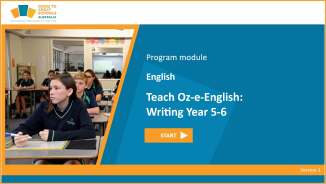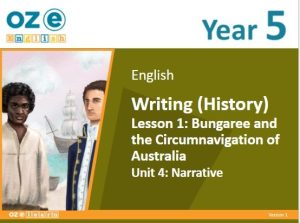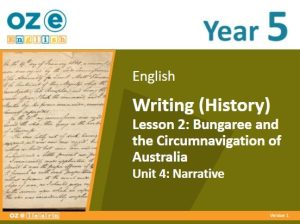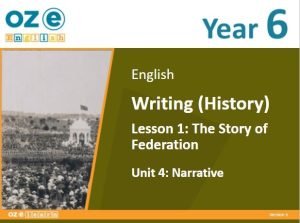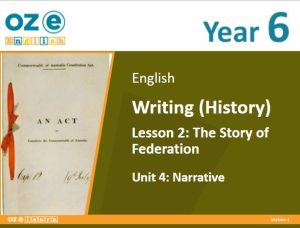Oz-e-English Writing (History)
Unit 4: Narrative
Free Starter Lessons
Year Overview
Year 5
Australian Curriculum Content Descriptions
Overview
Unit 4: Narrative – Year 5 is an English language strand unit for Year 5 students. It aligns to the Australian Curriculum English Year Level Achievement Standards:
- Plan, draft and publish imaginative, informative and persuasive print and multimodal texts, choosing text structures, language features, images and sound appropriate to purpose and audience (ACELY1704).
- Create literary texts that experiment with structures, ideas and stylistic features of selected authors (ACELT1798).
- Use comprehension strategies to analyse information, integrating and linking ideas from a variety of print and digital sources (AECLY1703).
It aligns to the Australian Curriculum: History Year Level Achievement Standards:
- Reasons (economic, political and social) for the establishment of British colonies in Australian after 1800 (ACHASSK106).
- The nature of the convict or colonial presence, considering the elements that impacted patterns of growth, characteristics of the daily lives of the locals (particularly Aboriginal Peoples and Torres Strait Islander Peoples), and how the environment changed (ACHASSK107).
- The effects of a noteworthy development or event on a colony in Australia (ACHASSK108).
- The reasons people migrated to Australia and the experiences and contributions of a certain migrant group within a colony (ACHASSK109).
- The influence a major person or group had on the development of a colony (ACHASSK110).
- The role that a significant individual or group played in shaping a colony (ACHASSK110).
- Present ideas, results, points of view, and conclusions using a variety of texts and formats that include source materials, analogue and digital representations, and terminology and customs particular to the discipline (ACHASSI105).
Note: The content on this page is subject to change as this program is being updated to comply with Australian Curriculum version 9.0 so may change at any time. GGSA will issue an updated version in the first quarter of 2024.
Learning Objectives
In Lessons 1 to 45, students will:
Learn about the structure of a factual recount. Learn the main facts about nine significant events from Australian history 1800s to 1900s analysing the perspectives from three groups: migrants, British colonists, and indigenous people.
- Circumnavigation of the Continent
- The Rum Rebellion
- The Black War
- Eureka Stockade
- Burke and Wills
- Coranderrk
- South Sea Islander Indentured Labour
- Bushrangers
- WA Pearl Trade
Examine the textual organisation and linguistic elements used in imaginative diaries, letter writing, and narrative recounts as part of a connected learning history course to offer personal perspective replies.
Analyse primary and secondary source documents supporting the focus of nine Australian historical events from 1800 to 1900.
Jointly write a narrative recount about Australian history 1800–1900s.
Success Criteria
- Identify the difference between primary and secondary sources.
- Identify the structure of a factual recount.
Retell the main facts about Australian history 1800s to 1900s. - Identify key vocabulary.
- Write factual sentences about Australian history 1800s to 1900s.
- Write descriptive paragraphs about Australian history 1800s to 1900s.
- Identify the sequenced facts of a historical event.
- Construct and improve a narrative recount by using sentence strip descriptions.
- Independently write a narrative recount from the first and third perspectives about Australian history 1800s to 1900s.
Assessment
Progress Tests
- A total of four progress tests worth a combined 40 per cent of the final grade are conducted in Weeks 2, 4, 6, and 9.
- Progress tests enable teachers to keep track of their students’ learning of the material covered and pinpoint areas that require additional instruction. The Student Workbook contains Progress tests.
End-of-Unit Assessment
- The end-of-unit assessment is given in Week 5, which contributes 60 per cent of the total grade. Each unit’s success criterion is addressed by this assessment, which is part of the Student Workbook.
Year 6
Australian Curriculum Content Descriptions
Overview
It aligns to the Australian Curriculum: English Year Level Achievement Standards:
- Identify responses to characters and events in literary texts, drawn from historical, social, or cultural contexts, by First Nations Australian, and wide-ranging Australian and world authors (AC9E6LE01).
- Plan, create, edit and publish written and multimodal texts whose purposes may be imaginative, informative, and persuasive, using paragraphs, a variety of complex sentences, expanded verb groups, tense, topic-specific and vivid vocabulary, punctuation, spelling and visual features (AC9E6LY06).
- use comprehension strategies such as visualising, predicting, connecting, summarising, monitoring, and questioning to build literal and inferred meaning, and to connect and compare content from a variety of sources (AC9E6LY05).
It aligns to the Australian Curriculum: History Year Level Achievement Standards:
- Composing informative and persuasive texts, supported by evidence, to describe and explain conclusions from their economic, civic, historical and geographical inquiries (AC9HS6S07).
- Study Australia’s path to Federation through an examination of key people and events (AC9HS6K01).
- Investigating how Australia’s system of law and government has origins in the Magna Carter, the English Civil War and Westminster system and therefore why we have a constitutional monarchy and why there was a separation of powers (legislative, executive, judiciary) (AC9HS6K01).
- Describing the significance of the 1962 right to vote federally and the importance of the 1967 referendum for First Nations Australians (AC9HS6K02).
- Investigating the developments in advancing democracy and citizenship for all citizens, including migrant groups, for example the establishment of the minimum wage, anti-discrimination legislation and official national multicultural policy (AC9HS6K02).
Learning Objectives
In Lessons 1 to 45, students will learn the main facts about eight significant events in twentieth-century Australian history:
- the formation of the Commonwealth of Australia at Federation in 1901
- Australia’s entry into WW1, the Gallipoli campaign and the legacy of ANZAC
- the wool and mining industry in Australia as the mainstays of the economy through much of the century
- Australia in the 1930s following the 1929 worldwide depression
- the Great Australian Silence – the history of Aboriginal and Torres Strait Islander people through the twentieth century
- Australia’ entry into WW11 and the imminent Japanese invasion of Australia
- the White Australian policy and the story of immigration
- the three stories of Australian migration
- use artefacts and source documents to write about the main facts about Australian history in the 1900s
- identify and use language features to write narrative recounts
- jointly construct narrative recounts about Australian history in the 1900s
- independently plan and draft narrative recounts about Australian history in the 1900s.
Success Criteria
- Identify the main facts of an informative text.
- Identify the key vocabulary.
- Participate in discussions and answer questions about significant events in Australian history in the 1900s.
- Identify and note facts about significant events in Australian history in the 1900s.
- Use artefacts and source documents from a factual recount to develop narrative language.
- Write descriptive paragraphs about significant events in Australian history in the 1900s.
- Use the main facts from the text and source documents to jointly construct narrative recounts about significant events in Australian history in the 1900s.
- Use the main facts from the text and source documents to independently construct narrative recounts about significant events in Australian history in the 1900s.
Assessment
Progress Test
- A total of four progress tests worth a combined 40 per cent of the final grade are conducted in Weeks 2, 4, 6, and 9.
- Progress tests enable teachers to keep track of their students’ learning of the material covered and pinpoint areas that require additional instruction. The Student Workbook contains progress tests. Marking guides are provided in the Lessons and Teaching Guides.
End-of-Unit Assessment
- The end-of-unit assessment is given in Week 7, which contributes 60 per cent (30 per cent English – 30 per cent History content) of the total grade.
- Each unit success criterion is addressed by this assessment, which is part of the Student Workbook.
Other Units
Lesson Design
Lesson Objective
Success Criteria
Activating Prior Knowledge
I Do
We Do
Apple Question
You Do
Revise
Professional Learning
